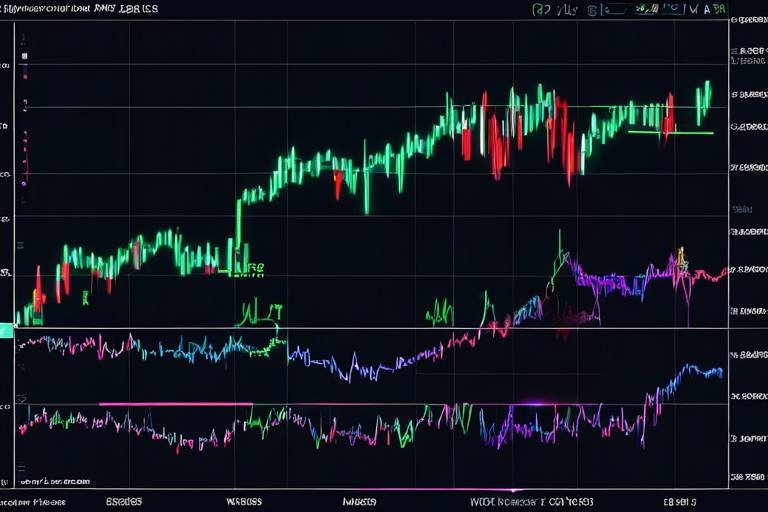How to Evaluate Cryptocurrency Exchanges Using Technical Tools
In the rapidly evolving world of cryptocurrency, choosing the right exchange can feel like navigating a maze. With countless options available, how do you ensure you’re making the right choice? This article explores the essential technical tools and methodologies for assessing cryptocurrency exchanges, ensuring users make informed decisions based on reliability, security, and performance metrics.
Before diving into the nitty-gritty of evaluation, it’s crucial to understand the different types of cryptocurrency exchanges. There are three primary categories: centralized exchanges, decentralized exchanges, and hybrid platforms. Centralized exchanges are like traditional banks, where a third party manages your transactions. On the other hand, decentralized exchanges operate on a peer-to-peer basis, giving users more control over their funds. Hybrid platforms aim to combine the best features of both worlds. Understanding these distinctions is crucial for evaluating their features and functionalities, as each type has its own set of advantages and drawbacks.
When it comes to evaluating cryptocurrency exchanges, identifying key performance indicators is essential. Metrics such as trading volume, liquidity, and fee structures can significantly impact your choice of exchange. Let's break these down further.
Analyzing trading volume provides insights into an exchange's popularity and reliability. A high trading volume often indicates a trustworthy platform with active users, which can be a good sign of liquidity and market interest. When evaluating trading volume, consider looking at the following:
- Average daily trading volume
- Volume trends over time
- Comparison with other exchanges
By examining these factors, you can gauge whether an exchange is a bustling marketplace or a quiet corner of the crypto world.
Liquidity is vital for executing trades efficiently. Imagine trying to sell a rare collectible; if there are no buyers, you’ll have to drop your price significantly. The same principle applies to cryptocurrency. A liquid exchange allows you to buy and sell assets without drastic price changes. To assess an exchange's liquidity, consider the following:
- Order book depth
- Bid-ask spread
- Market depth charts
By understanding these aspects, you can better predict how easily you can enter or exit trades without losing significant value.
Understanding the fee structures of exchanges is essential for cost-effective trading. Fees can vary widely, from transaction fees to withdrawal fees, and they can eat into your profits if you're not careful. Here are some common fee models:
| Fee Type | Description |
|---|---|
| Maker Fees | Fees charged for adding liquidity to the order book. |
| Taker Fees | Fees charged for taking liquidity off the order book. |
| Withdrawal Fees | Fees for withdrawing funds from the exchange. |
By comparing these fees across different exchanges, you can identify which platforms offer the best value for your trading style.
Security is paramount in cryptocurrency trading. With the rise of hacks and scams, ensuring your assets are protected should be your top priority. When evaluating exchanges, look for essential security features such as:
- Two-factor authentication (2FA)
- Cold storage options
- Regular security audits
By prioritizing security, you can trade with peace of mind, knowing your investments are safeguarded against potential threats.
A user-friendly interface enhances the trading experience. If an exchange is clunky and difficult to navigate, it can lead to costly mistakes. When assessing the usability and design of cryptocurrency exchanges, consider the following:
- Ease of navigation
- Quality of educational resources
- Customization options for charts and layouts
Remember, a well-designed platform can make all the difference between a smooth trading experience and a frustrating one.
Evaluating the differences between mobile and desktop platforms can influence trading efficiency. Mobile platforms offer the convenience of trading on the go, while desktop platforms often provide more comprehensive tools and features. Consider your trading habits—do you prefer the flexibility of mobile trading, or do you need the robust capabilities of a desktop interface?
Reliable customer support is crucial for resolving issues that may arise during trading. When evaluating the quality and responsiveness of an exchange's customer service, consider the following:
- Availability of support channels (chat, email, phone)
- Response times
- User reviews regarding support experiences
Good customer support can be the difference between a minor hiccup and a significant trading loss, so choose wisely!
Q: What is the most important metric when evaluating an exchange?
A: While all metrics are important, liquidity is often considered the most critical, as it affects how easily you can buy or sell assets without impacting the price.
Q: Should I only use centralized exchanges?
A: Not necessarily. While centralized exchanges offer convenience and often higher liquidity, decentralized exchanges provide more control over your funds. It really depends on your trading style and preferences.
Q: How can I ensure the security of my funds on an exchange?
A: Look for exchanges that implement strong security measures, such as two-factor authentication, cold storage for funds, and regular security audits.

Understanding Exchange Types
When it comes to diving into the world of cryptocurrency trading, it's essential to understand the different types of exchanges available. This knowledge is not just academic; it can significantly influence your trading experience and success. There are three main types of cryptocurrency exchanges: centralized exchanges, decentralized exchanges, and hybrid exchanges. Each of these platforms operates on unique principles and serves different purposes in the market.
Centralized exchanges are perhaps the most common type. They act as intermediaries between buyers and sellers, much like a traditional stock exchange. When you use a centralized exchange, you trust the platform to handle your transactions and safeguard your assets. Examples include Binance and Coinbase. While these exchanges often provide a user-friendly interface and high liquidity, they also come with risks, such as potential hacks and regulatory scrutiny. So, while they may seem like a safe bet, always remember that the phrase “not your keys, not your coins” holds true.
On the flip side, we have decentralized exchanges (DEXs). These platforms operate without a central authority, allowing users to trade directly with one another. Think of DEXs as a bustling marketplace where buyers and sellers interact directly, without a middleman. Popular examples include Uniswap and SushiSwap. The beauty of DEXs lies in their enhanced privacy and security features, but they can sometimes lack the liquidity and ease of use that centralized exchanges offer. Additionally, the user experience can be less intuitive, which might be a hurdle for newcomers.
Lastly, hybrid exchanges attempt to combine the best of both worlds. They offer the user-friendly interface and liquidity of centralized exchanges while also incorporating the security features of decentralized platforms. This means you can enjoy the convenience of trading without sacrificing the safety of your assets. However, hybrid exchanges are still relatively new, and their reliability can vary significantly from one platform to another.
Here's a quick summary of the differences:
| Exchange Type | Key Features | Pros | Cons |
|---|---|---|---|
| Centralized Exchange | Intermediary services, high liquidity | User-friendly, fast transactions | Security risks, regulatory issues |
| Decentralized Exchange | Direct trading, enhanced privacy | Greater security, control over assets | Less liquidity, complex for beginners |
| Hybrid Exchange | Combines features of both types | Convenient and secure | Variable reliability, still evolving |
In summary, understanding these exchange types is crucial before you start trading. Each has its unique advantages and drawbacks, and the right choice often depends on your individual trading needs and risk tolerance. Are you looking for high liquidity and ease of use? A centralized exchange might be your best bet. Prefer privacy and security? Then a decentralized exchange could be the way to go. And if you want a blend of both, keep an eye on hybrid exchanges as they develop. The world of cryptocurrency is vast and exciting, so take your time to explore these options!

Key Metrics for Evaluation
When diving into the world of cryptocurrency exchanges, it’s crucial to understand that not all platforms are created equal. The choices you make can significantly impact your trading experience and overall success. To help you navigate this complex landscape, we’ll explore some key performance indicators that you should consider when evaluating different exchanges. These metrics will not only shed light on the reliability of the platforms but also help you gauge their suitability for your trading needs.
One of the most important metrics to consider is trading volume. This figure indicates how much cryptocurrency is being bought and sold on an exchange over a specific period. A higher trading volume often signals a more active and popular exchange, which can be a good indicator of its reliability. Think of it like a bustling marketplace; the more traders you see, the more likely it is that you’ll find good deals and reliable service. A platform with low trading volume may not have enough liquidity, which can lead to slippage when executing trades.
Next up is liquidity, a term that’s often thrown around in trading circles. Liquidity refers to how easily you can buy or sell an asset without affecting its price. It’s crucial because high liquidity means you can execute trades quickly and at favorable prices. Imagine trying to sell a rare collectible; if there are plenty of buyers, you can sell it at a good price. However, if there are few buyers, you might have to lower your price significantly to make a sale. When assessing an exchange, look for metrics like the order book depth and market depth to understand its liquidity situation.
Another essential aspect to consider is the fee structure of the exchange. Different exchanges have different models for charging fees, which can impact your trading profits. Some platforms charge a flat fee per trade, while others might take a percentage of the transaction or offer tiered pricing based on trading volume. It’s vital to read the fine print and understand how these fees are structured. For instance, if you’re a frequent trader, a platform with lower fees could save you a significant amount over time. Here’s a quick comparison:
| Exchange Type | Fee Structure |
|---|---|
| Centralized Exchange | Flat fee or percentage per trade |
| Decentralized Exchange | Variable fees, often based on gas prices |
| Hybrid Exchange | Combination of both models |
Lastly, don’t overlook the security features of an exchange. In a space notorious for hacks and scams, knowing that your assets are secure is paramount. Look for exchanges that offer features such as two-factor authentication (2FA), cold storage for funds, and a solid track record of handling security breaches. Security should never be an afterthought; it should be a top priority. Remember, in the world of cryptocurrency, it’s better to be safe than sorry!
In summary, when evaluating cryptocurrency exchanges, pay close attention to these key metrics: trading volume, liquidity, fee structures, and security features. Each of these elements plays a critical role in determining the reliability and performance of the platform you choose. By doing your homework and analyzing these metrics, you’ll be well-equipped to make informed decisions that align with your trading goals.
- What is trading volume, and why is it important?
Trading volume indicates the amount of cryptocurrency traded on an exchange over a specific period. A higher volume often reflects a more active and reliable exchange. - How can I assess an exchange's liquidity?
You can assess liquidity by examining the order book depth and market depth, which show how easily assets can be bought or sold without affecting the price. - What are common fee structures for exchanges?
Exchanges typically charge either a flat fee or a percentage of the trade value. Some may also have tiered pricing based on your trading volume. - What security features should I look for in an exchange?
Look for two-factor authentication, cold storage for funds, and a strong history of managing security breaches effectively.

Trading Volume Insights
When diving into the world of cryptocurrency exchanges, one of the first metrics you should analyze is trading volume. Think of trading volume as the heartbeat of an exchange; it reflects the level of activity and engagement among users. A high trading volume often suggests that the exchange is not only popular but also reliable. Why is this important? Well, if an exchange has a large number of active traders, it typically means that you can execute trades quickly without significant price slippage, which is crucial in the fast-paced world of crypto trading.
But how can you gauge whether an exchange's trading volume is genuinely impressive? You can start by looking at the 24-hour trading volume, which gives a snapshot of how much cryptocurrency has been traded over the past day. This figure can be found on most exchanges and is a vital indicator of liquidity. For instance, if an exchange shows a 24-hour trading volume of $100 million, it indicates a healthy level of trading activity. In contrast, an exchange with only $1 million in trading volume might raise a red flag regarding its reliability and user engagement.
Moreover, comparing the trading volume of different exchanges can provide further insights. For example, if Exchange A has a trading volume of $500 million and Exchange B only has $50 million, it’s clear that Exchange A is preferred by traders. This preference can stem from various factors, including better security features, lower fees, or a more extensive selection of cryptocurrencies.
To illustrate this point, here’s a simple table comparing trading volumes of three popular exchanges:
| Exchange Name | 24-Hour Trading Volume | Number of Active Users |
|---|---|---|
| Exchange A | $500 million | 150,000 |
| Exchange B | $50 million | 20,000 |
| Exchange C | $200 million | 75,000 |
As you can see, Exchange A stands out with significantly higher trading volume and active users compared to the others. This indicates a more vibrant trading environment, which can be beneficial for your trading strategy.
In conclusion, paying close attention to trading volume is crucial when evaluating cryptocurrency exchanges. It not only reveals the exchange's popularity but also its reliability and liquidity. So, before you make a decision, ensure you’re looking at the trading volumes and comparing them across different platforms. This simple step can save you from potential headaches down the road and enhance your overall trading experience.
- What is trading volume? Trading volume refers to the total amount of cryptocurrency traded on an exchange over a specific period, usually 24 hours.
- Why is trading volume important? High trading volume indicates a more active market, which can lead to better liquidity and faster trade execution.
- How can I find an exchange's trading volume? Most cryptocurrency exchanges display their trading volume on their homepage or under specific trading pairs.
- What does low trading volume indicate? Low trading volume may suggest a lack of interest in the exchange, which could lead to issues like price slippage and difficulty in executing trades.

Liquidity Analysis
When diving into the world of cryptocurrency exchanges, liquidity is a term that often pops up, and for good reason. It refers to how easily you can buy or sell an asset without causing a significant impact on its price. Imagine trying to sell a rare collectible; if there are few buyers, you might have to lower your price significantly to make a sale. The same principle applies to cryptocurrencies. A highly liquid exchange allows for smooth transactions, meaning you can enter and exit positions quickly without worrying about price slippage or unexpected costs.
To assess liquidity on an exchange, you can look at several factors:
- Order Book Depth: A deep order book indicates that there are numerous buy and sell orders at various price levels, which contributes to better liquidity.
- Trading Volume: Higher trading volumes often correlate with greater liquidity. If an exchange regularly sees millions of dollars in trades, it’s likely easier to execute your orders without causing a price shift.
- Market Spread: The difference between the highest bid price and the lowest ask price is known as the spread. A narrower spread typically signifies better liquidity since it indicates that buyers and sellers are closely aligned in their pricing.
To illustrate these concepts further, here’s a simple table comparing the liquidity metrics of three popular exchanges:
| Exchange | Average Daily Trading Volume | Order Book Depth | Market Spread |
|---|---|---|---|
| Exchange A | $500 million | High | $0.01 |
| Exchange B | $250 million | Medium | $0.05 |
| Exchange C | $100 million | Low | $0.10 |
As you can see from the table, Exchange A has the highest trading volume and order book depth, making it a more liquid option compared to the others. This can be particularly beneficial for traders looking to execute large orders without impacting the market price. In contrast, Exchange C may pose challenges for traders, especially if they are looking to make substantial trades.
Furthermore, liquidity isn’t just a number; it can significantly influence your overall trading experience. A more liquid exchange means you can execute trades swiftly, which is crucial during volatile market conditions. On the flip side, if liquidity is low, you might find yourself stuck with an asset you can’t easily sell, or worse, forced to sell at a loss. Therefore, always keep an eye on liquidity when choosing an exchange, as it directly affects your trading strategy and potential profitability.

Fee Structures
When diving into the world of cryptocurrency exchanges, understanding is crucial for traders who want to maximize their profits and minimize costs. Fees can vary significantly across different platforms, impacting your overall trading experience. Most exchanges adopt one of several common fee models, including maker-taker fees, flat fees, and percentage-based fees. Each model has its unique implications for traders, so let’s break them down.
Firstly, the maker-taker fee model is prevalent among many exchanges. In this model, the maker is someone who places a limit order that adds liquidity to the order book, while the taker is a trader who places an order that matches an existing order. Typically, makers enjoy lower fees compared to takers, which incentivizes traders to add liquidity to the market. This structure can be beneficial for frequent traders who can strategically place their orders to minimize costs.
On the other hand, some exchanges opt for a flat fee structure, where users pay a fixed fee per transaction regardless of the trade size. This model can be advantageous for smaller trades, as it offers predictability in costs. However, for larger transactions, flat fees may not be as economical as percentage-based fees. For instance, if an exchange charges a flat fee of $2 per trade, a trader executing a $100 trade would incur a 2% fee, while a $10,000 trade would incur only a 0.02% fee.
Lastly, the percentage-based fee model charges users a percentage of the total trade value. This model is common among exchanges that cater to a wide range of trading volumes. While it can be advantageous for large trades, it may not be the best option for small-scale traders. Understanding how these fees accumulate over time is essential, especially for active traders who may execute multiple trades in a single day.
To illustrate the differences in fee structures, consider the following table:
| Exchange Type | Fee Model | Typical Fee Rate |
|---|---|---|
| Exchange A | Maker-Taker | 0.1% Maker, 0.2% Taker |
| Exchange B | Flat Fee | $2 per trade |
| Exchange C | Percentage-Based | 0.15% of trade value |
As you can see from the table, each exchange has its own fee structure, and the implications of these fees can vary widely based on your trading habits. Therefore, it’s vital to assess your trading style and choose an exchange that aligns with your financial goals.
Additionally, many exchanges offer discounts or incentives for using their native tokens to pay for trading fees. This can result in significant savings for frequent traders. As you evaluate different exchanges, always consider how fees can affect your overall trading strategy and profitability.
In conclusion, understanding the fee structures of cryptocurrency exchanges is not just about knowing the numbers; it's about making informed decisions that can save you money in the long run. Keep in mind that the most cost-effective exchange for one trader may not be the same for another, depending on trading volume and frequency.
- What are trading fees? Trading fees are charges incurred when buying or selling cryptocurrencies on an exchange.
- How can I minimize trading fees? You can minimize trading fees by choosing exchanges with lower fees, utilizing maker orders, or using native tokens for fee discounts.
- Do all exchanges have the same fee structures? No, different exchanges have varying fee structures, including maker-taker, flat, and percentage-based fees.
- Are there hidden fees in cryptocurrency exchanges? Some exchanges may have hidden fees, such as withdrawal fees or deposit fees, so it's essential to read the fine print.

Security Features
This article explores the essential technical tools and methodologies for assessing cryptocurrency exchanges, ensuring users make informed decisions based on reliability, security, and performance metrics.
Different types of cryptocurrency exchanges exist, including centralized, decentralized, and hybrid platforms. Understanding these distinctions is crucial for evaluating their features and functionalities.
Identifying key performance indicators such as trading volume, liquidity, and fee structures can significantly impact your choice of exchange. This section outlines the metrics to consider.
Analyzing trading volume provides insights into an exchange's popularity and reliability. High trading volume often indicates a trustworthy platform with active users.
Liquidity is vital for executing trades efficiently. This subsection discusses how to assess an exchange's liquidity and its implications for trading success.
Understanding the fee structures of exchanges is essential for cost-effective trading. This part examines different fee models and their impact on overall trading expenses.
Security is paramount in cryptocurrency trading. With the increasing number of hacks and scams in the crypto space, it’s essential to evaluate the of any exchange you consider using. First and foremost, look for exchanges that implement two-factor authentication (2FA). This additional layer of security requires not just a password but also something only you have, such as a mobile device, to access your account.
Another critical feature is the use of cold storage for the majority of user funds. Cold storage means that the funds are kept offline, making them less susceptible to hacking attempts. Exchanges that utilize cold storage typically allocate only a small percentage of funds to hot wallets for daily operations, which significantly reduces risk.
Additionally, consider the exchange's insurance policies. Some exchanges offer insurance for user funds in the event of a breach, providing an extra layer of peace of mind. While no system is entirely foolproof, knowing that your assets are insured can make a significant difference.
Other security features to look for include:
- Regular security audits: Ensure the exchange undergoes third-party security assessments to identify vulnerabilities.
- Withdrawal whitelist: This feature allows users to set specific addresses for withdrawals, adding an extra layer of security against unauthorized transactions.
- Transparent security practices: Exchanges that openly share their security measures and incident response plans tend to be more trustworthy.
In summary, when evaluating a cryptocurrency exchange, pay close attention to these security features. They are not just technical jargon; they are essential safeguards that protect your investments. Always prioritize platforms that demonstrate a commitment to user security, as this will provide you with a safer trading experience.
A user-friendly interface enhances the trading experience. This section explores how to assess the usability and design of cryptocurrency exchanges.
Evaluating the differences between mobile and desktop platforms can influence trading efficiency. This subsection discusses the advantages and disadvantages of each format.
Reliable customer support is crucial for resolving issues. This section highlights how to evaluate the quality and responsiveness of an exchange's customer service.
Q1: What should I look for in a cryptocurrency exchange?
A1: Look for security features, user experience, trading volume, liquidity, and fee structures.
Q2: Is it safe to use a cryptocurrency exchange?
A2: While no exchange is completely risk-free, choosing one with robust security features can significantly reduce your risk.
Q3: How can I verify an exchange's security?
A3: Check for two-factor authentication, cold storage practices, insurance policies, and independent security audits.

User Experience and Interface
When diving into the world of cryptocurrency trading, the user experience and interface of an exchange can make all the difference between a smooth sailing journey and a frustrating ordeal. Think of it as the cockpit of an airplane; if the controls are confusing or cluttered, even the most skilled pilot can struggle to navigate. A well-designed interface not only enhances usability but also significantly improves your overall trading efficiency. So, what should you look for in a cryptocurrency exchange's user experience?
First and foremost, intuitive navigation is key. You want to be able to find what you're looking for without feeling like you've entered a labyrinth. A clean layout with clearly labeled sections allows traders to move seamlessly from one feature to another. Imagine trying to find your way through a busy market with no signs; it would be overwhelming, right? The same goes for a trading platform. An intuitive design can help users focus on making informed decisions rather than getting lost in the interface.
Moreover, visual appeal plays a crucial role. A visually pleasing interface can make the experience enjoyable. Colors, fonts, and graphics should be well-coordinated and easy on the eyes. While this may seem trivial, studies show that aesthetic elements can significantly impact user satisfaction and engagement. Just think about it: would you prefer to trade in a dull, outdated platform or one that feels modern and vibrant?
Another aspect to consider is the availability of educational resources. Many exchanges now include tutorials, guides, and even demo accounts to help new users familiarize themselves with the platform. This is especially important for those who are just starting their trading journey. Having access to educational tools can empower users and build their confidence, making the trading experience less daunting.
Additionally, it’s essential to evaluate the mobile versus desktop experience. With more people trading on-the-go, a responsive mobile app can be a game-changer. However, it’s important to note that mobile platforms often have limitations compared to their desktop counterparts. Users should assess whether they prefer the convenience of trading from their smartphones or the comprehensive features available on a desktop. Here’s a quick comparison:
| Feature | Mobile Platform | Desktop Platform |
|---|---|---|
| Accessibility | Highly accessible, trade anytime, anywhere | Requires a computer, but offers more features |
| User Interface | Compact, may sacrifice some details | More space for detailed charts and tools |
| Performance | May be slower, depending on internet | Generally faster with better processing power |
| Notifications | Instant alerts, great for quick trades | Alerts may be missed if away from desk |
Finally, let’s not overlook the importance of customer support. A trading platform can look great and function well, but what happens when you encounter an issue? Reliable customer support is crucial for resolving problems quickly. Look for exchanges that offer multiple channels of communication, such as live chat, email, and phone support. Quick response times and knowledgeable staff can greatly enhance your trading experience, providing peace of mind that help is just a click away.
In conclusion, evaluating the user experience and interface of a cryptocurrency exchange is not just about aesthetics; it's about finding a platform that facilitates your trading journey. A well-designed exchange can save you time, reduce stress, and ultimately help you make better trading decisions. So, take the time to explore different platforms and find one that resonates with your style and trading needs.
- What should I look for in a cryptocurrency exchange? Focus on user experience, security features, supported currencies, and customer support.
- Is a mobile app necessary for trading? While not necessary, a mobile app can offer convenience and flexibility for traders on the go.
- How important is customer support? Extremely important! Reliable customer support can help resolve issues quickly and efficiently.
- Can I use both mobile and desktop platforms? Yes, many traders use both to take advantage of the strengths of each platform.

Mobile vs. Desktop Platforms
When it comes to cryptocurrency trading, the choice between mobile and desktop platforms can significantly influence your overall experience. Imagine you're on the go, sipping your morning coffee, and you suddenly want to check the latest price of Bitcoin. A mobile platform allows you to do just that, bringing the market to your fingertips. However, if you're at home, sitting comfortably in front of your computer, a desktop platform might offer a more immersive and detailed trading experience. So, how do you decide which one is right for you?
First off, let's talk about mobility. Mobile platforms are designed for traders who are always on the move. They offer the flexibility to trade from anywhere, whether you’re at the gym, commuting, or waiting in line. Most mobile apps come equipped with essential features like price alerts, real-time charts, and even biometric security options. This means you can react quickly to market changes, which is crucial in the fast-paced world of cryptocurrency.
On the flip side, desktop platforms tend to provide a more comprehensive trading environment. They often come with advanced charting tools, multiple screens, and a larger interface that can display more information at once. This is particularly beneficial for traders who rely on technical analysis and need to monitor several cryptocurrencies simultaneously. The larger screen real estate allows for a more detailed view of market trends and data, making it easier to make informed decisions.
Another factor to consider is user experience. Mobile apps are generally designed for quick interactions and ease of use. They prioritize essential functionalities and often have intuitive designs. However, this can sometimes mean sacrificing depth for simplicity. Desktop platforms, while potentially overwhelming at first glance, usually offer more robust features that can enhance your trading strategy. For example, many desktop exchanges allow for complex order types and custom indicators that may not be available on mobile apps.
Now, let’s break down some key differences in a table:
| Feature | Mobile Platforms | Desktop Platforms |
|---|---|---|
| Accessibility | Available anywhere, anytime | Limited to desktop or laptop |
| User Interface | Simple, user-friendly | More complex, feature-rich |
| Performance | Optimized for quick trades | Better for extensive analysis |
| Security | Biometric options available | Generally more secure with software firewalls |
In summary, the choice between mobile and desktop platforms often comes down to your trading style and lifestyle. If you value flexibility and the ability to trade on the go, a mobile platform may be your best bet. Conversely, if you prefer a detailed analysis and a comprehensive trading experience, then a desktop platform is likely the way to go. Ultimately, many traders find a combination of both works best, allowing them to capitalize on opportunities no matter where they are.
- Can I use both mobile and desktop platforms? Yes, many traders use both to take advantage of their respective benefits.
- Are mobile trading apps secure? Most reputable apps offer strong security features, but always do your research.
- Which platform is better for beginners? Mobile platforms may be easier for beginners due to their user-friendly design.

Customer Support Services
When diving into the world of cryptocurrency exchanges, one aspect that often gets overlooked is the quality of . Imagine you're in the middle of a trade, and suddenly, you encounter a glitch or a question arises about your account. If you can't get help quickly, it can feel like being stranded in the middle of the ocean without a life raft. This is why evaluating customer support is crucial for any trader, whether you're a seasoned pro or just starting out.
To assess the effectiveness of an exchange's customer support, consider the following factors:
- Availability: Does the exchange offer 24/7 support? In the fast-paced world of cryptocurrency, having access to support at any hour can make a significant difference.
- Communication Channels: Check what channels are available for support. Are they reachable via live chat, email, or phone? The more options, the better, as different users have different preferences.
- Response Time: How quickly do they respond to inquiries? A rapid response time can indicate a well-organized support team.
- Knowledge Base: Does the exchange provide a comprehensive FAQ section or help center? A good knowledge base can empower users to solve issues independently, saving time for both the user and the support team.
It's also wise to look for user reviews and testimonials regarding customer support. These can provide real-world insights into how effectively an exchange handles issues. For example, if you find multiple reports of slow response times or unresolved issues, it might be a red flag. On the flip side, glowing reviews about fast and helpful support can give you confidence in your choice.
In addition, consider the complexity of the issues you might face. If you're dealing with large sums of money or intricate transactions, having reliable support can be a game-changer. Some exchanges even offer dedicated account managers for high-volume traders, which can enhance the overall experience.
In summary, never underestimate the importance of customer support services when evaluating a cryptocurrency exchange. It’s not just about trading; it’s about feeling secure and supported throughout your trading journey. After all, in the world of crypto, where the stakes can be high, having a reliable support system can mean the difference between a successful trade and a costly mistake.
- What should I look for in customer support? Look for availability, response time, communication channels, and a comprehensive knowledge base.
- How can I test the customer support of an exchange? You can send a query via different channels and measure how quickly and effectively they respond.
- Is 24/7 support necessary? While not strictly necessary, 24/7 support is highly beneficial in the volatile world of cryptocurrency trading.
Frequently Asked Questions
- What are the different types of cryptocurrency exchanges?
There are three main types of cryptocurrency exchanges: centralized exchanges, decentralized exchanges, and hybrid platforms. Centralized exchanges act as intermediaries, providing a user-friendly experience but requiring users to trust the platform with their funds. Decentralized exchanges allow users to trade directly without a middleman, enhancing privacy and control. Hybrid platforms combine features of both, aiming to offer the best of both worlds.
- How can I evaluate the trading volume of an exchange?
To evaluate the trading volume, you can check the exchange's statistics on its website or through third-party analytics tools. A high trading volume often indicates a popular and reliable platform, as it reflects the number of trades occurring over a specific period. It’s like checking the foot traffic in a store; more customers usually mean a better shopping experience!
- What does liquidity mean, and why is it important?
Liquidity refers to how easily you can buy or sell an asset without affecting its price. High liquidity means there are plenty of buyers and sellers, making it easier to execute trades quickly. Think of it as a busy marketplace where you can always find someone to trade with, compared to a quiet street where you might wait ages to make a deal.
- What should I know about fee structures on exchanges?
Fee structures can vary widely between exchanges and can include trading fees, withdrawal fees, and deposit fees. It's crucial to understand these fees because they can significantly impact your overall trading costs. Some exchanges charge a flat fee, while others use a tiered system based on your trading volume. Always read the fine print!
- How can I assess the security features of an exchange?
When evaluating security features, look for two-factor authentication (2FA), cold storage of funds, and insurance policies against hacks. Additionally, check if the exchange has a history of security breaches. A secure exchange is like a well-guarded fortress; it should keep your assets safe from intruders!
- Is user experience important in cryptocurrency trading?
Absolutely! A user-friendly interface can make trading smoother and more enjoyable. If an exchange is difficult to navigate, you might miss out on profitable opportunities. Think of it as using a complicated map versus a clear GPS; one helps you reach your destination faster!
- What are the advantages of mobile vs. desktop platforms?
Mobile platforms offer the convenience of trading on the go, allowing you to make quick decisions anytime, anywhere. Desktop platforms, on the other hand, often provide more comprehensive tools and a larger screen for analysis. It’s like choosing between a pocket knife for quick fixes and a full toolbox for detailed projects!
- How can I evaluate customer support services of an exchange?
To evaluate customer support, check for availability (24/7 support is ideal), response times, and the channels offered (live chat, email, phone). You can also read reviews from other users to gauge their experiences. Reliable customer support is crucial; it’s like having a dependable friend to help you out in tricky situations!



















